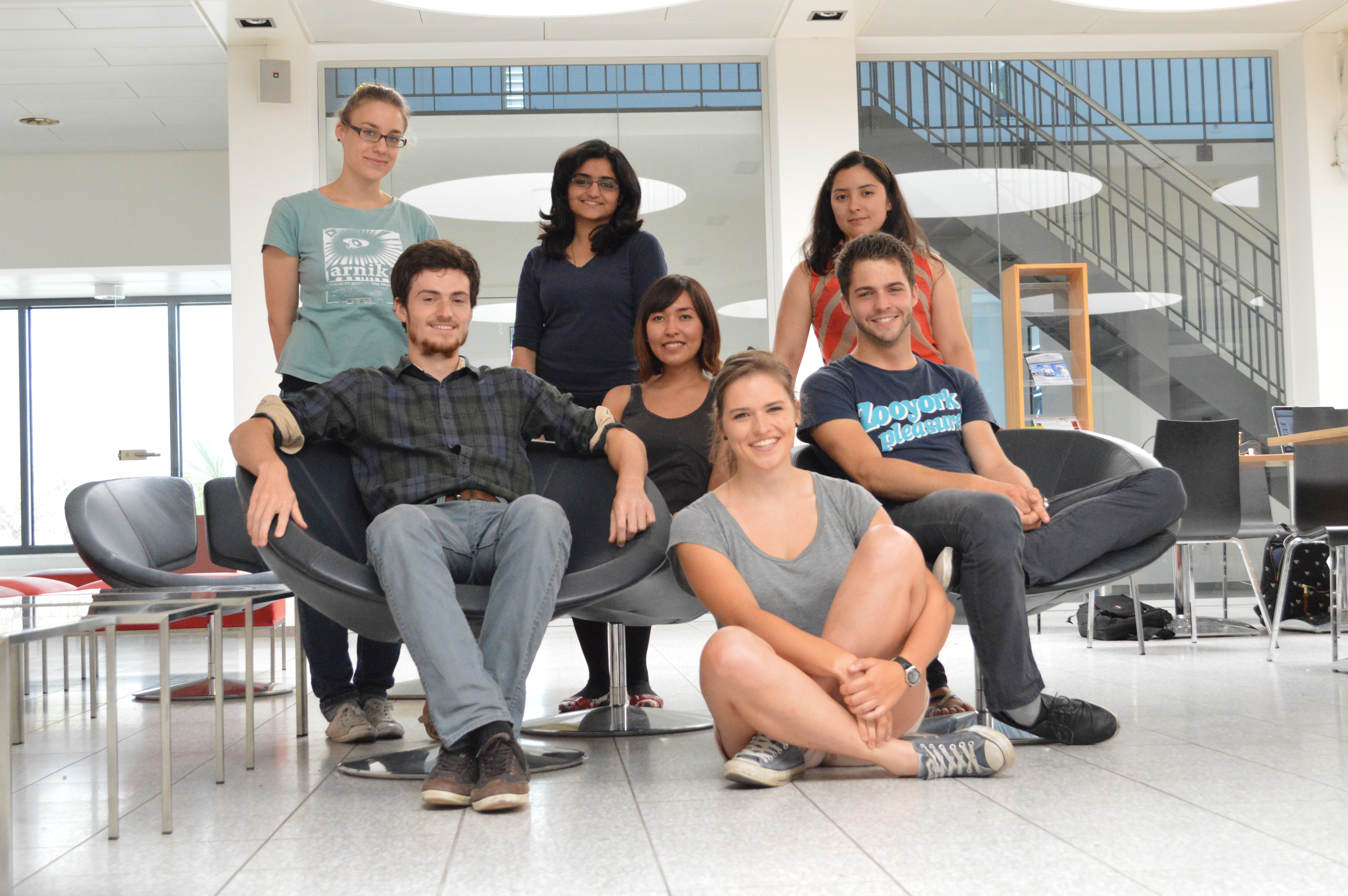Team:ETH Zurich/Templates/Test3
From 2013.igem.org
| Line 10: | Line 10: | ||
<p style="font-size:14.5px" align="justify"><b>Colisweeper</b><br>Colisweeper is an interactive, biological version of the Minesweeper computer game, based on quorum sensing and chromogenic enzymatic reactions. The goal is to clear an agar “minefield” without detonating mines. Genetically engineered <i>Escherichia coli</i> colonies are used as sender-cells (mines) and receiver-cells (non-mines). Mines secrete the signaling molecule AHL whereas non-mines process the signal. To distinguish between AHL-levels, a library of PLuxR promoters with various sensitivities was created through site-saturation mutagenesis. High-pass filters were constructed to control the expression of different orthogonal hydrolases in non-mines, depending on the number of surrounding mines. Additionally, the mines express their own hydrolase.<br></p> | <p style="font-size:14.5px" align="justify"><b>Colisweeper</b><br>Colisweeper is an interactive, biological version of the Minesweeper computer game, based on quorum sensing and chromogenic enzymatic reactions. The goal is to clear an agar “minefield” without detonating mines. Genetically engineered <i>Escherichia coli</i> colonies are used as sender-cells (mines) and receiver-cells (non-mines). Mines secrete the signaling molecule AHL whereas non-mines process the signal. To distinguish between AHL-levels, a library of PLuxR promoters with various sensitivities was created through site-saturation mutagenesis. High-pass filters were constructed to control the expression of different orthogonal hydrolases in non-mines, depending on the number of surrounding mines. Additionally, the mines express their own hydrolase.<br></p> | ||
</li> | </li> | ||
| + | <li><p style="font-size:14.5px" align="justify"><b>Gameplay</b><br>To play Colisweeper, the player always have two options. He can either play and thus reviel the identity of the colonie or flag it in case of a mine. Therefore either a colorless substrate for flagging or another colorless substrate mix for playing is pipetted onto a colony of choice. The result is a defined color change within minutes, allowing identification of the played colony and the number of mines surrounding it.<br> | ||
| + | </p></li> | ||
<li><p style="font-size:14.5px" align="justify"><b>From Minesweeper to Colisweeper</b><br> Mines secrete the signaling molecule AHL whereas non-mines process the signal. High-pass filters were constructed to control the expression of different orthogonal hydrolases in non-mines, depending on the number of surrounding mines. The constant expression of lacZ enables the flagging of both mines and non mine cells. Additionally, the mines express their own hydrolase. | <li><p style="font-size:14.5px" align="justify"><b>From Minesweeper to Colisweeper</b><br> Mines secrete the signaling molecule AHL whereas non-mines process the signal. High-pass filters were constructed to control the expression of different orthogonal hydrolases in non-mines, depending on the number of surrounding mines. The constant expression of lacZ enables the flagging of both mines and non mine cells. Additionally, the mines express their own hydrolase. | ||
</p></li> | </p></li> | ||
| Line 18: | Line 20: | ||
<a href="https://2013.igem.org/Team:ETH_Zurich/Project"><img src="https://static.igem.org/mediawiki/2013/3/3f/Colisweeper.png" /></a> | <a href="https://2013.igem.org/Team:ETH_Zurich/Project"><img src="https://static.igem.org/mediawiki/2013/3/3f/Colisweeper.png" /></a> | ||
</li> | </li> | ||
| - | <li> | + | <li> |
<a href="/Team:ETH_Zurich/Project"><img src="https://static.igem.org/mediawiki/2013/c/ce/Gameplay.png"/></a> | <a href="/Team:ETH_Zurich/Project"><img src="https://static.igem.org/mediawiki/2013/c/ce/Gameplay.png"/></a> | ||
| - | + | </li> | |
| - | + | ||
| - | + | ||
<li> | <li> | ||
| Line 67: | Line 67: | ||
$(document).ready(function(){ | $(document).ready(function(){ | ||
slider = $('#bxslider').bxSlider(); | slider = $('#bxslider').bxSlider(); | ||
| - | sliderText = $('#bxsliderText').bxSlider({'responsive': false, 'pager': false, 'auto': false}); | + | sliderText = $('#bxsliderText').bxSlider({'responsive': false, 'pager': false, 'auto': false, 'controls': false}); |
$('#bxsliderText').parent().css({"display": "table", "height": "100%", "width": "100%", "position": "relative"}); | $('#bxsliderText').parent().css({"display": "table", "height": "100%", "width": "100%", "position": "relative"}); | ||
$('#bxsliderText').parent().parent().css({"display": "table-cell", "height": "100%", "padding-bottom": "70px", "padding-right": "40px", "position": "relative", "width": "25%"}); | $('#bxsliderText').parent().parent().css({"display": "table-cell", "height": "100%", "padding-bottom": "70px", "padding-right": "40px", "position": "relative", "width": "25%"}); | ||
Revision as of 16:04, 25 September 2013
Colisweeper is an interactive, biological version of the Minesweeper computer game, based on luxI/luxR quorum sensing and chromogenic enzymatic reactions. The goal is to clear an agar “minefield” without detonating mines.
Genetically engineered Escherichia coli colonies are used as sender-cells (mines) and receiver-cells (non-mines). Mines secrete the signaling molecule N-(3-oxohexanoyl)-l-homoserine lactone (OHHL) whereas non-mines process the signal. To distinguish between OHHL-levels, a library of PLuxR promoters with various sensitivities was created through site-saturation mutagenesis. High-pass filters were constructed to control the expression of different orthogonal hydrolases in non-mines, depending on the number of surrounding mines.
Additionally, the mines express their own hydrolase.A spatiotemporal reaction-diffusion model was established to evaluate and improve the system. To play Colisweeper, a colorless substrate solution is pipetted onto a colony of choice. The result is a defined color change within minutes, allowing identification of the played colony and the number of mines surrounding it.
 "
"















